
The cabinet door finish doesn’t just define the appearance of your kitchen, it also shapes how you feel in the space every day. Each type of kitchen cabinet door material has its own personality: warm and natural, sleek and modern, luxurious and refined, or boldly distinctive.
Understanding the differences is the first step toward creating a harmonious, personalized, and long-lasting living space. This article will guide you through the characteristics of each surface material, helping you choose the one that best matches your style and everyday needs.
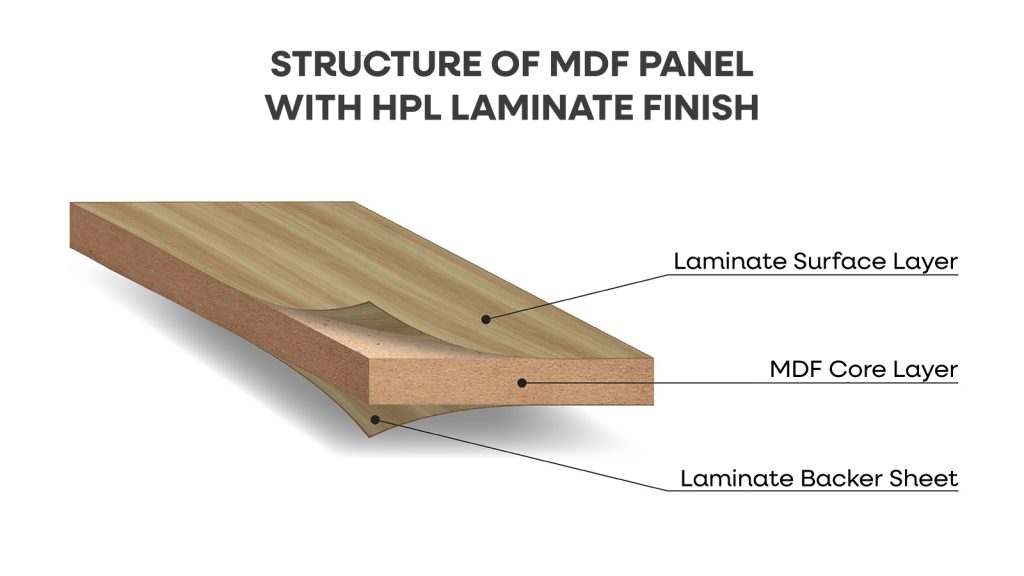
Laminate is one of the most commonly used surface finishes in modern kitchen cabinet design. Depending on its composition and manufacturing process, laminate is categorized into the following main types:
| Key Advantages | Limitations to Consider |
| – High durability: Excellent scratch, heat, and moisture resistance. – Easy to clean: Smooth surface that resists stains and allows effortless maintenance. – Aesthetic variety: Wide range of options including solid colors, wood grains, stone patterns, and matte textures. – Affordable: More accessible in price compared to many other materials. | – Limited shaping flexibility: Cannot achieve soft, curved edge profiles like paint or veneer finishes. – Difficult to repair: Surface is hard to restore if peeling or delamination occurs. – Perceived as less premium: May appear less sophisticated if the color or grain selection is not well chosen. |
Laminate is ideal for modern kitchens that prioritize clean lines, easy upkeep, and flexible color coordination.
Lacquer is a premium paint finish. Unlike laminate (a surface layer applied onto a wood base), lacquer is sprayed directly onto the panel surface and undergoes multiple stages of sanding, painting, and polishing. This results in a smooth finish with distinctive color depth. Lacquer surfaces can be completed in various finishes:
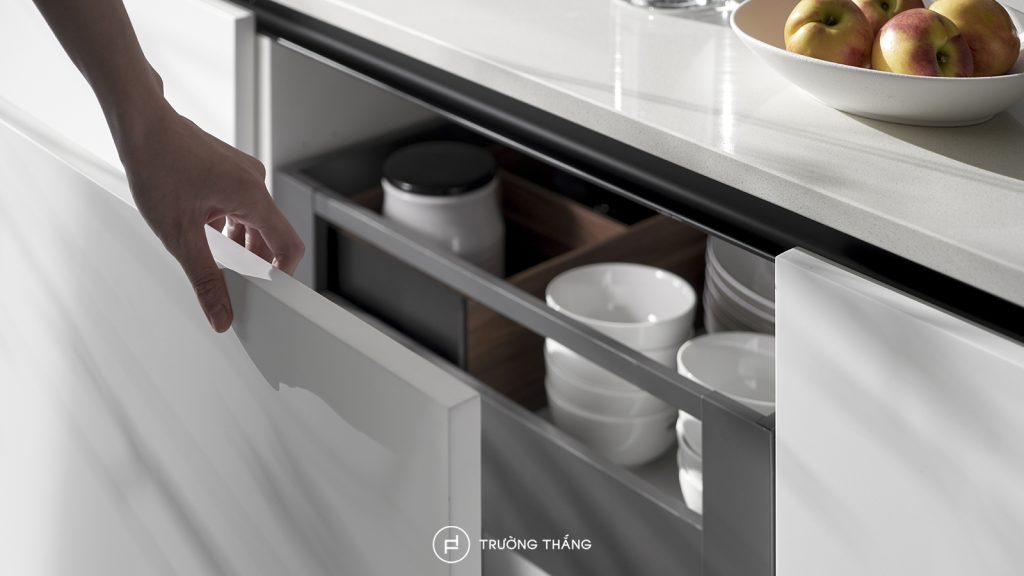
| Key Advantages | Limitations to Consider |
| – High aesthetic value: seamless, smooth surface offers a premium and sophisticated feel. – Unlimited color choices: can be custom-mixed to match any tone – from pure white, matte black, smoky gray to bold hues or soft pastels. – Material versatility: commonly paired with glass, metal, stone, or veneer to create layered, visually striking designs. – Surface can be touched up: minor scratches on matte finishes can be polished out for restoration. | – More prone to scratching than laminate under strong impact, especially with high-gloss finishes. – Sensitive to impact & sharp objects: requires careful handling during daily use and cleaning. – Skilled craftsmanship required: improper application can lead to surface waviness, uneven coating, or fading over time. – Higher cost compared to laminate or melamine, especially for multi-layer finishes or custom-mixed colors. |

If aesthetics are your top priority and you’re looking for a smooth, elegant surface with flexible color options, lacquer is a strong contender.
Veneer is a thin slice of real wood (typically 0.3 – 0.6 mm thick), shaved directly from tree trunks and applied onto engineered wood cores such as MDF or HDF.
It is a popular solution in high-end interiors for those who want to preserve the natural beauty of solid wood. While ensuring greater stability, reduced weight, and a more economical approach compared to using solid timber.
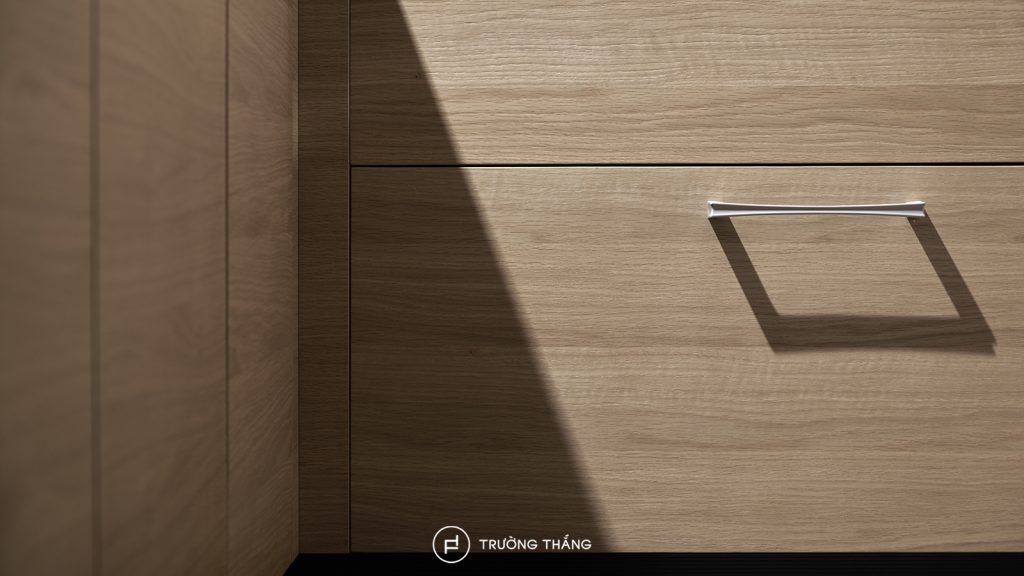
| Key Advantages | Limitations to Consider |
| – Natural aesthetics: Preserves the authentic grain and color of real wood. – Lighter than solid wood: Reduces structural load while maintaining a premium look and feel. – Versatile in combination: Pairs beautifully with other materials like lacquer, glass, metal, or stone to create layered, expressive designs. – Multiple finishing options: Can be finished in matte, gloss, or oil-based coatings, suitable for various interior styles, from classic to contemporary. | – Sensitive to water and humidity: Without proper installation or protective coating, veneer edges may peel or warp. – Difficult to repair deep scratches: Due to its thinness, veneer cannot be sanded or restored like solid wood. – Requires careful surface treatment: Needs a protective finish (such as PU or NC coating) to improve durability and moisture resistance. – Highly variable in cost: Prices can range widely depending on wood species, grain pattern, and rarity. Some veneer options can be nearly as expensive as solid wood. |
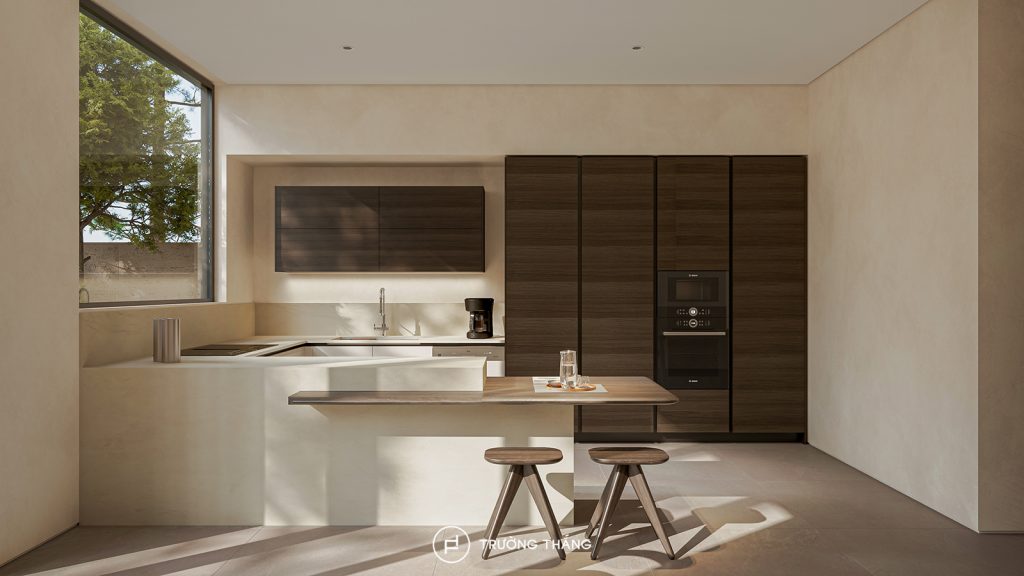

Solid wood is the most traditional material in furniture making. Without artificial coatings or surface laminations, the wood is processed, cut, and shaped directly from the tree trunk, giving each cabinet door a truly unique and authentic appearance.
Thanks to advancements in processing technology, solid wood is no longer reserved solely for classic designs. Today, it’s widely and flexibly applied in high-end modern and transitional interiors. Especially when paired with stone, glass, or metal for a refined, contemporary aesthetic.
| Key Advantages | Limitations to Consider |
| – Authentic and luxurious appearance: rich grain patterns and natural tones bring depth and elegance. – Exceptional durability: when properly treated, solid wood can last for many years with minimal degradation. – Refinishable surface: solid wood can be sanded and refinished to restore its original beauty after prolonged use. – High craftsmanship potential: allows for intricate moldings, curved edges, or carved details, ideal for classic or neoclassical styles. | – Heavy and prone to warping if not treated properly: requires careful kiln-drying and pressing to reduce shrinkage or expansion from humidity changes. – High cost: varies based on wood species, rarity, and sourcing origin. – Requires careful maintenance: avoid prolonged exposure to water, high heat, or direct sunlight. – Inconsistent color tones: each wood slab has a unique hue and grain, demanding expert craftsmanship to match grains and ensure a consistent cabinet front. |
Though not the most budget-friendly option, solid wood remains a timeless symbol of durability, elegance, and personal character in interior design.


Aluminum & glass cabinet fronts feature a framed structure using extruded aluminum and 4–6mm tempered glass panels, a combination increasingly favored in modern kitchen designs.
Depending on the design, the aluminum frame can be powder-coated in finishes such as black, gray, or silver, and paired with various glass types: frosted, striped, clear, or reflective. This allows for a refined balance between privacy and contemporary aesthetics.
| Key Advantages | Limitations to Consider |
| – Sleek and refined aesthetics: Slim aluminum frames paired with glass panels create a lightweight, airy look that doesn’t overwhelm the space. – Absolutely warp- and termite-resistant: Unaffected by humidity, making it highly suitable for tropical climates like Vietnam. – Easy to clean: Smooth surfaces require minimal maintenance. – Creates a sense of openness: Especially effective in compact kitchens or open-plan layouts that connect to the living room. | – Limited formability: Not suitable for curved designs or intricate carvings. – Prone to fingerprints and smudges: Especially with glossy glass surfaces, requiring careful cleaning. – Risk of cracking: May crack or chip if subjected to strong impact. – Can feel cold or sterile: Should be thoughtfully combined with warmer materials like wood veneer or solid wood to balance the ambiance. |
When thoughtfully designed and paired with complementary materials, aluminum and glass cabinet fronts can become the perfect balance between functionality, elegance, and spaciousness in any modern kitchen.


Using natural stone, engineered stone, or ceramic/porcelain as cabinet door materials is a rising trend in high-end kitchen design. Especially for contemporary minimalist spaces.
Unlike traditional cabinet materials, stone introduces a refined edge and substantial feel, often featured on large cabinet fronts or kitchen islands to create a luxurious statement. Depending on your priorities, you can choose from:
| Key Advantages | Limitations to Consider |
| – Highly resistant to scratches, moisture, and heat: Especially ideal for cooking zones and kitchen islands. – Long-lasting surface durability: Resists fading, warping, or damage from temperature and humidity. – Creates bold visual accents: Adds a luxurious, statement-making touch to the space. – Easy to maintain: Non-porous surface repels stains and cleans effortlessly with a simple wipe. | – High cost: Especially for imported stones or premium technical ceramics. – Heavy weight: Requires a sturdy cabinet frame to ensure safety and durability. – Limited in shaping possibilities. – Overuse of stone surfaces may reduce the space’s warmth: Best paired with warmer materials like veneer or fabric for balance. |
When used thoughtfully, stone is more than just a material. It becomes a bold aesthetic statement and a symbol of independent design spirit. It sets your kitchen apart and leaves a lasting impression.
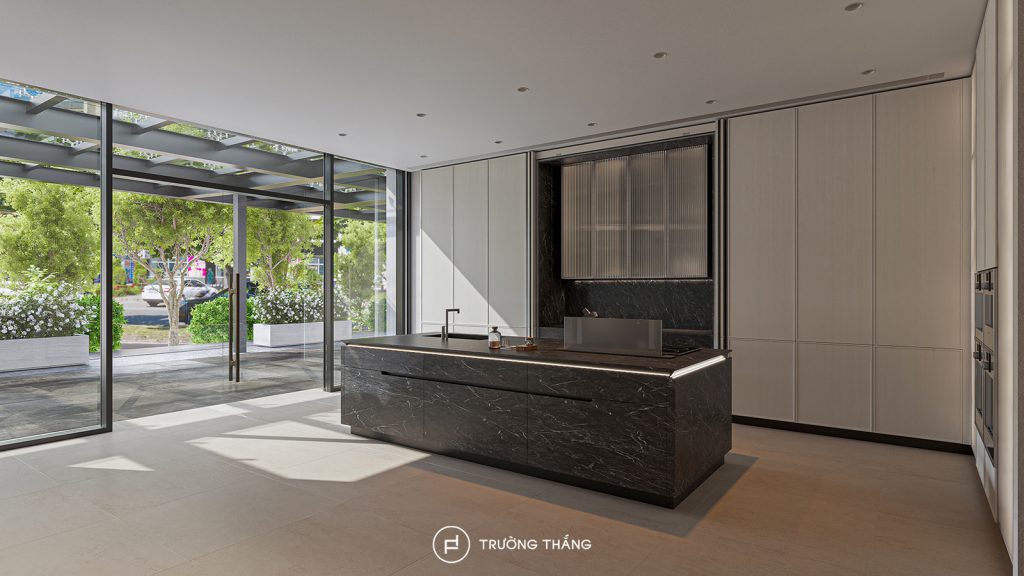
| Material | Key Advantages | Limitations | Suitable Style | Cost |
| Laminate | Durable, scratch-resistant, easy to clean, wide range of colors. | Limited in soft detailing, may look less premium if poorly selected Modern, minimalist. | Modern, minimalist | ★★ |
| Lacquer paint | Smooth, seamless finish, customizable colors, high-end feel. | Prone to scratches, requires skilled application, higher cost. | Modern, luxurious, personalized | ★★★ |
| Natural wood veneer | Authentic wood grain, warm aesthetic, lighter than solid wood. | Sensitive to moisture, difficult to repair deep damage. | Warm, natural, elegant | ★★★★ |
| Solid wood | Highly durable, refinishable, timeless appeal. | Heavy, expensive, requires careful maintenance. | Classic, neoclassical, rustic | ★★★★★ |
| Aluminum & glass | Lightweight, airy, fully moisture-resistant. | Limited shaping options, fingerprints may show. | Modern, industrial, minimalist | ★★★★ |
| Stone | Extremely durable, heat-resistant, stain-resistant, bold visual impact. | Very heavy, high cost, limited shaping. | Premium, minimalist, statement design | ★★★★★ |
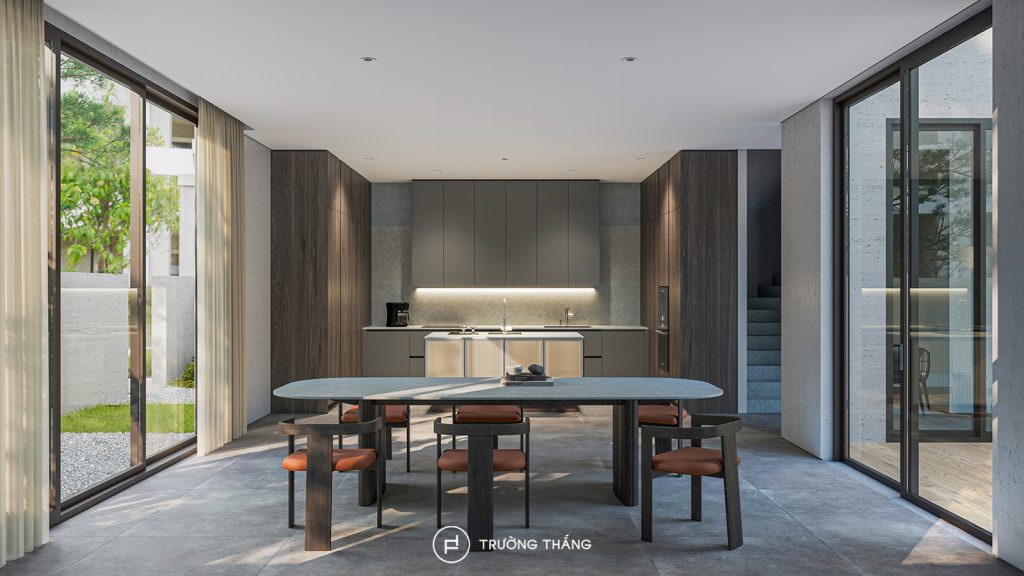

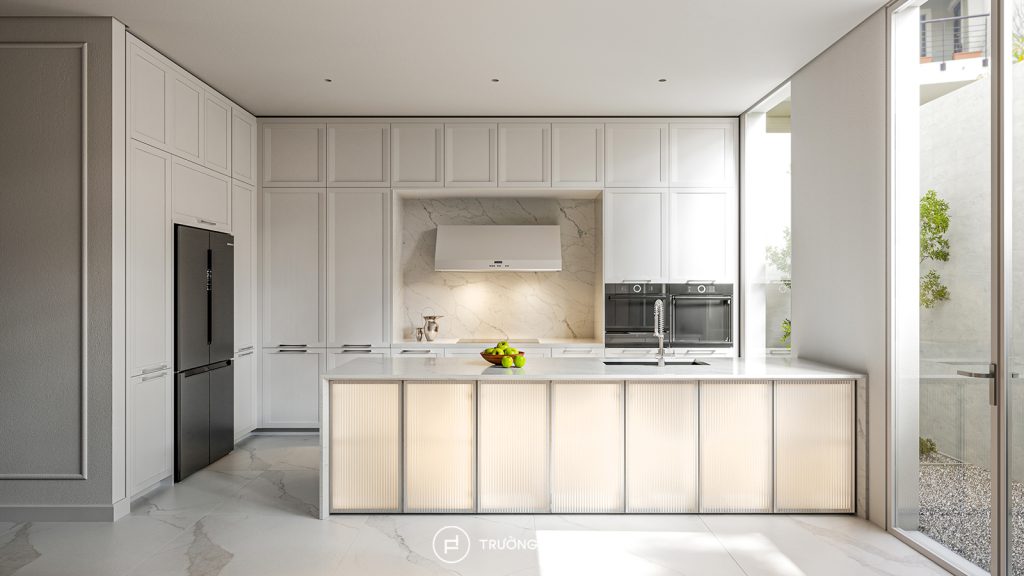
There’s no single “best” material for every kitchen – only the most suitable one for your space, usage habits, and aesthetic preferences.
In fact, well-designed and visually rich kitchens often mix different door materials to create contrast, define zones, or balance overall ambiance.
For example:
This thoughtful layering of materials not only adds depth and character but also helps optimize your budget. Reserving premium materials for areas that truly deserve attention.
If you’re looking for the right cabinet door material, let Truong Thang help you evaluate your real needs, recommend the best material combinations and functions, and create a kitchen that’s truly your own.

Founded in 2004, Truong Thang has been driven by the vision of building a premium, sustainable interior ecosystem. We are committed to delivering high-quality products that are safe for your health. At the same time, our solutions are tailored to the needs and lifestyle of Vietnamese families.
If you’re looking for interior design and build solutions for your home, Truong Thang is a trusted choice. We offer products crafted from premium materials, with refined design and flexible application across various styles and modern living spaces.